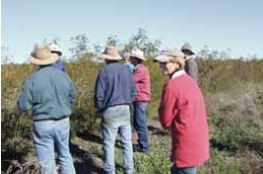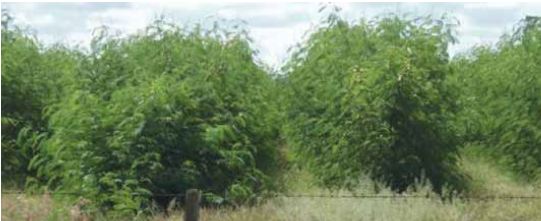



Leucaema in Queensland: Recipe for Success?
Australian beef producers, particularly in the Darling Downs, would benefit from a persistent summer perennial and, according to Meat and Livestock Australia (MLA), Leucaena could be the thing.This article from MLA is part of the Feedbase and Pasture series and concentrates on the merits of growing Leucaena in southern inland Queensland and how to achieve good results.
Using examples at its Producer Demonstration Site (PDS), MLA shows which varieties can work and the best way to manage the crop. As a trial, the PDS hopes to set out the best sites, cultural requirements, row spacing, grazing management and animal performance - including stocking rates.
Why Is the Leucaena Rumen Bug Needed?

Cattle must be inoculated with the special rumen bacteria to properly detoxify DHP, which is formed in the rumen from mimosine in the leucaena plant. Inoculate by drenching 10% of animals with the rumen bacterium after they have been on leucaena-based pasture for a couple of weeks. These introduced ‘bugs’ break down the DHP and avoid any possibility of reduced appetite in cattle.
The bacteria will spread to other cattle quite readily so new animals should be introduced to leucaena while inoculated animals are still present. It is a good idea to always keep some inoculated animals on leucaena to provide an ongoing source of the bacteria.
Potential Uses in South East Queensland
On suitable sites, leucaena has been the premier summer-growing legume available for mixed legume– grass pastures. Beef production per ha from these pastures is very reliable and far greater than with grass alone. Over 300kg of liveweight gain per ha has been measured from leucaena pastures in good seasons; however, 200–250kg liveweight gain per hectare would be typical in average seasons.
The shrub is very drought tolerant. Leucaena will grow when day temperatures are above 20°C. On the Darling Downs, this means sustained growth is likely to occur from October to April. In areas out of the severe frost zones, good growth occurs from mid-September to mid- May, the best growth occurring when adequate soil moisture is available during summer.
Best yield measured: Cunningham in 3.5m rows – 4,400kg DM/ha from September to February.
Choosing a site for Leucaena
Temperature
Choose a site that is on undulating country out of the severe frost line.
For seed to germinate, soil temperatures need to average 18°C or above. That requires minimum night temperatures to exceed 15°C and day temperatures around 25°C.
Leucaena is frost sensitive and likely to be severely frosted in low lying and flood plain country. Frosts down to -8°C have killed all above ground plant material, so regrowth has to come back from the crown. This can be slow. Frosts down to -4°C have not damaged above ground parts and regrowth starts from along the stems and branches.
Soil and water requirements
Choose good quality soils with adequate water holding capacity (130mm+ PAWC).
On these soils, production will be higher and more reliable. If fertilising is necessary, such soils will give better, much less risky returns from the investment.
For good growth in a 600mm (24") rainfall area, leucaena requires a deep soil with plant available water capacity (PAWC) of at least 130mm – similar to the requirements to grow grain crops. On good clay soil in reliable rainfall areas, leucaena will grow well in 5–7m wide rows and produce about 3,000kg dry matter per ha/year.
In drier areas or in shallower soils, this can be manipulated by growing it in wider rows, for example, 8–10m wide. A strategy used in inland central Queensland is to keep grass 2m away from both sides of the planted rows, especially until the leucaena plants are well established. Leucaena is suitable for the majority of Darling Downs soils (calcareous, alkaline soils of high natural fertility).
It has moderate salt tolerance (about the same as barley). Leucaena has a high requirement for phosphorus (P), potassium (K) and sulphur (S) and can respond to zinc (Zn) on very alkaline soils. It is preferable to have the soil tested (surface plus profile) before planting.
Good responses to sulphur fertiliser have been obtained on basaltic soils after the leucaena is five years old.
Sulphur deficiency reduces the effectiveness of nodulation and associated fixation of nitrogen. Yellowing leaves indicate that nitrogen fixing by the soil bacteria (rhizobium) is inadequate. Specialist advice should be sought if ineffective nodulation is suspected.
Cultural Requirements
Seed treatments
Use fresh seed; don’t keep scarified seed for more than 12 months.
Mechanically scarified seed is preferred. Before planting, the seed should be treated with the special leucaena rhizobium inoculant to ensure effective root nodulation. Soil insects such as false wire worms, earwigs and cockroaches can play havoc with germinating leucaena seedlings so assessing options for control is very important.
Check with local farmers in your area to find out if these insects are a problem with establishing summer grain crops. See your local agronomist for more information on insecticide options.
Land preparation
Treat the land preparation and sowing operations the same as for grain sorghum.
Zero till systems provide the best environment for the establishment of leucaena because the moisture is retained around the seed longer.
Sub-soil moisture: store it and control the weeds.
Before planting, there must be a reserve of sub-soil moisture to keep the plants going for three months in summer, in which time follow up rain has hopefully been received. At least 70cm of wet soil is required before attempting to plant. Weed control is essential.

Keep weeds out from 2m either side of the leucaena row until the plants are 1.5–2.0m tall. Good weed control enables the bushes to grow faster and stronger and provide feed quicker.
Chemical weed control is possible. If weeds are coming up at planting time, spray with glyphosate herbicide at 1–1.5L/ha, depending on the type of weeds and their size. Spray immediately after the planting, as long as there are no leucaena plants up and the weeds are young and fresh.
Alternatively, use Spinnaker® (140gm/ha) as a preemergent two weeks before planting (best), at planting,or when the leucaena is in the true leaf stage. It is mildly phototoxic but plants grow out of it fairly quickly. If rain is received after planting, and the potential weeds are not legumes, expect 3–6 months of weed-free conditions (depending on rainfall). Spinnaker® will not kill legumes so be aware that native legumes such as sesbania and rhynchosia will not be controlled.
Spray at least 1–2m either side of the row. The rest of the inter row spacing can be worked or treated with a shielded sprayer using other appropriate herbicides.
In southern Queensland it is suggested that grass seed be planted as soon as possible after the leucaena goes in. Keep grass seed at least 1–2m either side from establishing leucaena rows.
Another alternative is to introduce leucaena into a good pasture paddock. This can be done by ploughing up 4m wide strips leaving 4m widths of grass to achieve alternating 4m wide cultivated strips (in which leucaena is planted) and 4m wide grass. This works fine in good summer seasons, but when moisture is limiting, full grass control will give the best results.
Zero till can be practiced in a pasture paddock, as long as the pasture has set seed during the last two summer seasons. To do this, spray out all the grass with glyphosate and utilise the grass seed bank to enable regeneration after the leucaena has established. It should be kept weed free during the fallow period.
If the pasture hasn’t set seed in the previous summer seasons, apply some fresh seed after the leucaena has established. Spray the 4m wide strip for the leucaena with spinnaker to control all weeds from seed. Do not spray the whole area with spinnaker as it will act as a full pre-emergent spray.
Planting
Fertilise with 40kg/ha of phosphorus (P) in the planting zone if your soils have a colwell P level below 25mg/kg (0.10cm soil depth). If you cannot fertilise with the seeder, pre-apply the P in the metre strip in which you aim to plant. Use ordinary super if you suspect sulphur deficiency (basaltic soils or old cultivations).
Plant 3–4cm deep into a weed-free seed bed, the shallower the better but don’t sacrifice depth for moisture – always plant into moisture.
Sow using a row planter that can accurately metre the seed out at one seed every 2–3cm. Double this spacing if using twin rows 1m apart with an inter-row spacing of 5–8m wide. The planter should have twin press wheels that push soil in from the sides to avoid compressed soil directly over the row.
Rabbits, hares, wallabies, kangaroos, ducks, grass hoppers and soil insects eat young leucaena. Plant at least 20ha (some recommend 40ha minimum) so there is plenty to go around if these animals are about.
Insect baiting
If soil insects are known to be a problem, bait in between the rows of leucaena using the mixture below (quantities below are suitable for 1ha, applying it 1m either side of the row). The bait: 2.5kg of cracked grain 120ml of vegetable oil (sunflower or linseed oil) 100ml of lorsban
Grass
It is very important to establish grass between leucaena rows to provide good ground cover and improve animal productivity from the pasture. Plant grass pastures in between the rows of leucaena immediately after planting the leucaena. Keep grass seed at least 1–2m away from planted leucaena rows.
Buffel, green panic, Gatton panic, rhodes grass, bambatsi, premier digit and bisset creeping blue grass are all suitable. Plant a mixture of any three of these at 2–4kg/ha. Floren bluegrass is suitable on heavy soils, especially in wet areas.
Leucaena As a Weed
The Leucaena Code of Practice, produced by The Leucaena Network, has guidelines to minimise any weed potential of leucaena.
The main points are:
• Don’t plant leucaena close to gullies or drainage lines that lead to major water courses.
• Keep it at least 20m away from external fence lines.
• Graze or cut leucaena to keep it within reach of animals to minimise seed set.
• Establish and manage vigorous grass in the inter-row and around the edge of the paddock.
• Kill any plants that escape from leucaena plantations.



